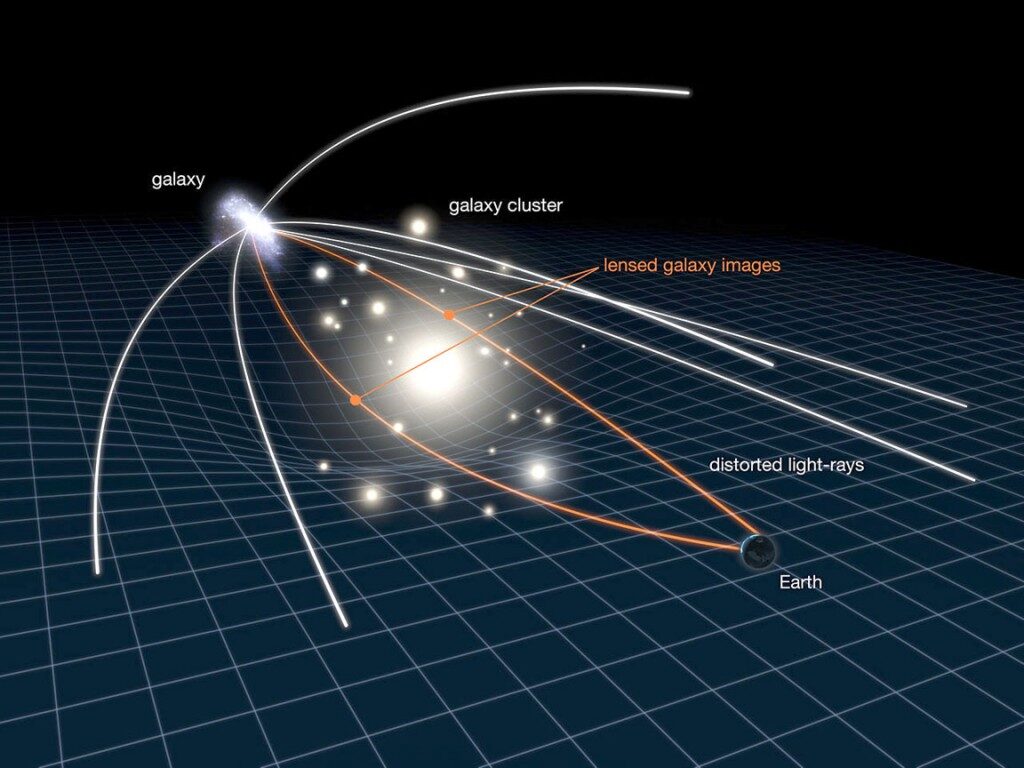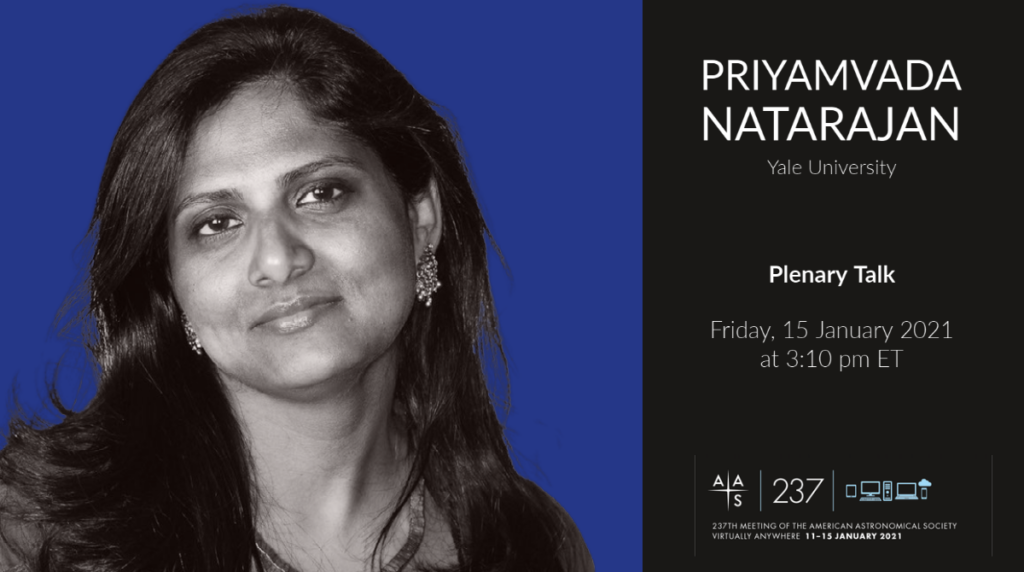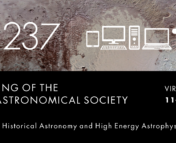In this series of posts, we sit down with a few of the keynote speakers of the 237th AAS meeting to learn more about them and their research. You can see a full schedule of their talks here, and read our other interviews here!
Breaking the Standard
For the last two decades, one model for understanding large-scale structure in the universe has been held up as the “standard model” of cosmology: ΛCDM, which consists of the cosmological constant (Λ, denoting the accelerating expansion of the universe) and cold dark matter (CDM, where “cold” means non-relativistic) along with normal matter. So far, ΛCDM is the simplest cosmological model that is largely consistent with observations… but some cracks are starting to show.
Dr. Priyamvada Natarajan is trying to push at those cracks. Natarajan, a professor at Yale Astronomy and Physics, is a theoretical astrophysicist who has studied diverse topics ranging from the growth of black holes over cosmic time to the outflows around quasars. At her #AAS237 plenary talk, she will focus on “stress-testing ΛCDM” in one of her longest-running projects.
“We’re trying to use clusters of galaxies as astrophysical labs and cosmological probes,” Natarajan explains. “Clusters of galaxies are very interesting: they’re the most massive, recently formed structures, so they’re the most efficient [gravitational] lenses.” If there’s a source of light located on the far side of a galaxy cluster, the light from that source will be deflected by the cluster in a process called gravitational lensing (Figure 1).
The amount that light gets deflected “depends only on the projected mass in a cylinder all the way between us and the distant source.” This allows us to measure the mass distribution of a galaxy cluster, which can then be compared with simulations.. “It’s a new way to test ΛCDM that I’ve been interested in since I was a graduate student,” she says.

A big small-scale problem
Testing ΛCDM using galaxy cluster lensing measurements is tricky work! Natarajan describes it as a “cat and mouse game”: in order to compare ΛCDM simulations with cluster observations, the resolutions of the simulations and observations have to match. “What you ideally want to do is a mock observation with the simulations,” she says.
When Natarajan’s group did this comparison, they found a problem: the simulations predicted a spatial distribution of matter inside clusters that was “completely off” from observations! Additional measurements (from the velocity dispersions of galaxies in clusters, which are correlated with galaxies’ total masses, and from the way galaxy clusters distort light on small scales) showed discrepancies between observations and simulations. Those discrepancies, Natarajan says, indicate that “the simulations are a lot less concentrated in terms of mass distribution than in the real universe.”
“Small-scale” problems with ΛCDM are nothing new. For example, the “cusp/core problem” (related to the density profiles of dark matter subhalos) has only recently been solved with higher-resolution simulations that include more physics. But this problem that Natarajan’s group has identified with strong lensing galaxy clusters can’t be solved as easily! “We’re left with two options,” Natarajan says. “One option is that there’s something wrong with the method, with the simulations—that we’re missing some physical process that occurs in the universe that is relevant on this scale.” This would be a big deal, since “in cosmology, we can’t do controlled experiments in the lab. We have one universe in which we make measurements, [and] simulations are our only controlled experiments.”
The other option is that the ΛCDM assumptions about dark matter are wrong! “This is very exciting for me,” Natarajan enthuses. “It’s the culmination of more than 15 years of work, of trying to use cluster lensing to diagnose CDM […] I think [this result] is important enough that we should pursue both possibilities and see where things stand.”
A non-linear life
Although Natarajan has been working on this cluster lensing project for 15 years, her path to this field wasn’t straightforward. “I have not been a strategic person in terms of my career,” she laughs. Natarajan did her undergrad at MIT on a scholarship from India, where she studied pure math and physics. “I was just the kind of person that people would have loved to recruit for string theory!” But she also tried several research experiences in undergrad, which helped her figure out what exactly she liked about research—and pure math wasn’t quite what she wanted to do. “There was an interrogation process that excited me about science,” Natarajan says. “For me, building even a simple conceptual model and comparing it with a single data point and seeing if I can explain it […] That’s what I loved.”
At the same time, Natarajan was interested in fields outside science. “I have been a very interdisciplinary person. I loved to write, loved history, loved art,” she says. She had also learned from a young age the importance of giving back to the community. “When I finished at MIT, I thought, ‘Oh my God, I am so selfish. I have been thinking only about my career, what have I done to improve others’ lives?’” So she deferred for two years before starting graduate school—and during that time off, she did a project in rural South India.
“I had read an article about how the World Bank had designed water pumps for villages in India that were more efficient […] but for some reason they’re not being used.” She visited some villages to try to figure out the problem. Almost as soon as she got to one of the villages, she figured out the problem: “It was the way in which you had to stand in order to use the pump—women wearing saris couldn’t use it—it compromised their modesty!” It was an important lesson for Natarajan. “That made me realize that the context of science and technology is really, really important. There’s no point in making brilliant discoveries if you’re not attuned to the people who are going to use them.”
She then started a PhD—not in astronomy or physics, but in history and philosophy of science. “I was going to work on epistemology in a field like cosmology, where you don’t have lab experiments,” she says. She made it three years into the program before she happened to meet Martin Schwarzschild, who convinced her to go to the University of Cambridge for a PhD in astrophysics and work with Martin Rees. “I never really went back to finish that first PhD!” Natarajan notes. “But over the years, i have wanted to write books about these ideas that i’ve been thinking about.” Her first book, published in 2016, explores how radical, paradigm-shifting ideas have contributed to the history of cosmology.
What advice does Natarajan have for junior scientists? “Figure out what about research you like, and follow your heart,” she says. “Even if it means that you won’t get the traditional success in a linear way—you know, life is nonlinear. We all need to figure out our own version of success. The success that you want is what you think is right for you, and that is in better alignment with you.” At the same time, she adds, “there’s no way around hard work and mastery.” If you decide to pursue an academic research career, “you ultimately have to enjoy this kind of pushing past your own limitations to learn!”
Natarajan is optimistic about the outlook for younger generations of scientists. “Our scientific culture is more toxic than it should be, but you know, we are the culture. We make the culture. I think younger people are realizing that we have to make the culture that we aspire to.
“We need to move past crude competitiveness—who better than us, as astronomers and physicists, to have that cosmic perspective?”
To learn more about Dr. Natarajan’s cosmic perspective (at least on cosmology), check out her plenary talk at 3:10PM EDT on Friday, January 15 at #AAS237!

Astrobite edited by: Gourav Khullar
Featured image credit: American Astronomical Society

